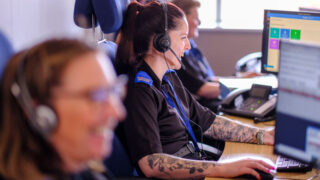Cash-strapped police forces are filling some key job vacancies with unpaid volunteers amid ongoing cutbacks, says a report published by UNISON which highlights the fact that an increasing reliance on unpaid volunteers demonstrates the financial pressures the service is under.
The report, Crossing the Line – Police support volunteers: rising numbers and mission creep – is based on responses to Freedom of Information requests in 2017 from 34 forces across England and Wales.
These showed that the number of volunteers helping police has grown by 15% since UNISON last undertook a similar survey in 2014.
How many and what do they do?
There are now more than 6,000 such volunteers. The map gives a force-by-force breakdown of the use of police support volunteers, and the change in numbers since 2014. Over the same period, government figures show that the number of employed police staff dropped by 4,177 – or 5% – from 80,749 to 76,572.
But let’s take a look at those figures in a bit more detail.
As well as police forces across the two countries using more and more volunteers, they are often asking those volunteers to take on more and more roles. The chart below above shows how many police support volunteers there are, and the number of different roles filled by them, in each force that answered our FoI request.
There is a wide variety in the number of roles reported by each force, or each UNISON branch – from three in the West Midlands to 82 in West Yorkshire.
This is because – at least in part – of differences in recording and reporting what police support volunteers do.
Some forces have reported quite generic roles. For instance, the three roles reported for the West Midlands include “volunteer”. Others have reported quite specific roles. Among West Yorkshire’s roles for volunteers, for instance, we find everything from “administrator”, through “DNA recovery lab”, “HR clerical support”, “public enquiry counter” and “stable hand assistant” to “Viper identification assistant”.
It can often be unclear just what some of these volunteer roles involve, especially when opaque acronyms are used. But, on the face of it, many of them seem to involve work that would normally be done by a paid member of staff. And that is something which concerns UNISON.
On top of that, the 2017 Police and Crime Act gave chief constables the right to award all police powers to volunteers – bar seven ‘reserved’ powers such as using firearms, arresting people, or carrying out stop-and-searches.
Since then, one force – Lincolnshire, which did not respond to UNISON’s FoI request – has introduced volunteer police community support officers into its ranks. And the 2017 Act gave volunteer PCSOs the right to use CS and PAVA sprays.
Concerns
UNISON has no objection to volunteers being given the resources they need to carry out appropriate tasks – but the union does object to volunteers being put into positions where CS or PAVA spray would need to be used.
More widely, the union is concerned about using volunteers in operational roles where it would not be possible to deploy them in emergencies, because they do not have a contract of employment and cannot be forced to turn out in such situations.
Using volunteers in this way risks putting them, police staff and the public in danger.
And those concerns will only increase as a greater use of volunteers, alongside increasing staff cuts, mean they make up an increasing proportion of the police’s personnel resources (see graph above).
Another area of concern is around the information individual forces, and the Home Office, collect and keep on the use of volunteers.
In 2014, UNISON asked forces to provide or estimate the costs associated with their use of volunteers. The responses suggested that it was rare for any force to be able to do that.
And in 2016, the Citizens in Policing national benchmarking exercise found that “the understandings of financials related to police volunteering … is limited in many forces,” with “little consistency in financial responses”.
Given that, UNISON decided not to repeat that question in the latest FoI request.
But we did ask about the hours that volunteers were working. Ten forces responded that they did not record the hours worked by police support volunteers.
All of them reported using significant numbers of volunteers – ranging from 117 to 348 – and five of them feature in the 10 forces with the highest number of volunteers.
UNISON’s response
UNISON believes the data revealed by the FoI request raises a number of important questions about whether volunteers are being used to substitute for paid roles which have been cut, as well as more general concerns about appropriate use.
The union also has questions about transparency and information, not just on numbers but also on costs, deployment, and impact, “so that trends could be assessed and forces held properly accountable”.
General secretary Dave Prentis warned that there is the potential for both the police and the public to be put at risk by the growth in volunteer use, and in the roles they’re asked to cover.
“The concern is they’re being taken on partly to compensate for the loss of tens of thousands of paid police staff and officers as a result of government cuts,” he said.
“Volunteers can be valuable to police forces, especially in building bridges with communities. But they should never be used as a replacement for highly trained and properly-vetted police staff.
Demographic breakdown
Similarly, we asked for equality data from each force, breaking down their volunteer force to see how many of them were women, and how many came from the Black – or BME in police terms – community.
While a few forces had significant gender disparities – Kent, for instance, reported 225 male volunteers and 123 female – and two, Durham and Essex did not record volunteers’ gender, or not in a retrievable format, the overall distribution was relatively equal.
Across all the forces that answered the FOI request, though, there was a slightly higher total number of male volunteers, 2,784, than female, 2,484.
On ethnic identity, eight forces did not record the data at all. Those that did reported a total of 252 volunteers recorded as “BME”.
Home Office figures
Since UNISON’s Freedom of Information request, the Home Office has started collecting some data on police support volunteers. In March 2018, it published its first official figures numbers, which gave a total number of volunteers across all forces – including the British Transport Police (115), the Met (0) and city of London Police (11) – of 7,152.
The Home Office count only includes volunteers over 18 who have been vetted by their force. This does not include neighbourhood watch and police watch volunteers, or police cadets.
This may explain some discrepancies such as Hampshire reporting “more than 1,122 volunteers” to UNISON in 2017, but the Home Office only recording 499 in 2018.
The official figures also recorded that the gender split among such volunteers was 50.2% male and 49.8% female. They do not record other and non-binary genders.
The same figures show that 6.6% of police support volunteers across England and Wales are what they call “minority ethnic”.
UNISON’s FoI Request
UNISON submitted a Freedom of Information in request in July 2017 to forces in England and Wales where the union organises – so excluding London’s Metropolitan Police and City of London Police, as well as the British Transport Police.
It asked question about volunteer numbers, roles, hours worked, gender and ethnic breakdowns.
34 forces responded to the request, including Hampshire Constabulary, whose response stated that the force had “over 1,122 volunteers” but did not hold the information requested in a retrievable format and that to access the relevant information would cost in excess of £450.




